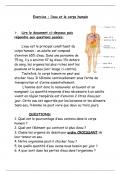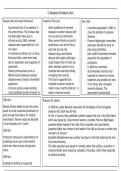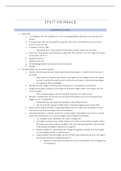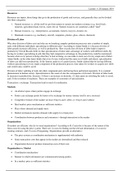SPONTANEOUS PROCESSES
▪ A spontaneous process is one that takes place without continuous intervention by us. A good
example of a spontaneous process is the mixing up of two gases.
The key point, however, is that the reverse of a spontaneous process never happens on its own. A
mixture of two gases will never separate on their own and we can separate a mixture of gases by
liquefying followed by distillation.
▪ Another example of a spontaneous process is the reaction between ammonia and hydrogen
chloride to form ammonium chloride. NH3 (g) + HCl (g) → NH4Cl (s)
However, ammonium chloride does not spontaneously decompose into ammonia and hydrogen
chloride, it requires the heating of ammonium chloride. NH4Cl (s) → NH3 (g) + HCl (g)
▪ From the point of view of thermodynamics, all reactions are reversible, therefore it’s worth to see
When a reaction reaches a point of equilibrium, what determines whether the equilibrium will favour
the reactants or the products, and to what extent? This question is answered using the concept
‘entropy’
ENTROPY
▪ Entropy is a property of matter that is associated with the degree of disorder or degree of
randomness.
The scientific term for disorder is entropy.
▪ Entropy refers not only to the distribution (disorder/randomness) of molecules but also to the
ways of distributing the energy between the particles.
▪ The entropy of the particles in the three states of matter are increased in the following order.
Ssolid < Sliquid < Sgas
A ‘perfect’ crystal is one in which the internal lattice
structure is the same at all times. In otherwords the
particles (atoms, molecules or ions) are fixed and are
not moving in anyway, rotating or vibrating.
The third law of Thermodynamics states that the
entropy of a perfect crystal at the temperature of
absolute zero (i.e. 0 K) is zero.
Edexcel IAL Chemistry Eranga S. Gamlath B.Sc(Hon’s) 1
, ▪ Entropy measures the degree of randomness, so you would expect a gas to have a larger entropy,
than its liquid form, and a liquid to have a larger entropy than its solid form.
Substance Entropy, S/ J K-1mol-1
Water vapour 189
water 70
ice 48
DISTRIBUTION OF MOLECULES
▪ The following diagram shows two gas jars. The bottom one contains bromine gas and the top one
contains air.
When the cover slip between the two gas jars is removed, the
bromine and air diffuse so that the molecules of each gas are
spread out evenly throughout both gas jars.
▪ To understand why this happens we can look at a much simpler example where there are only five
molecules. The following diagram shows two gas jars. The left-hand jar contains five molecules of
bromine and the right-hand jar contains no molecules.
▪ Each molecule has two possible
arrangements; It can be either the left-
hand jar or the right-hand jar. We can
write the number of possible
arrangements for molecule 1 as W1, and
the number of possible arrangements
for molecule 2 as W2, and so on.
As there are two possible arrangements for molecule 1, W1 = 2. For molecule 2, W2= 2, and so on.
The equation for the total number of ways, W, that the five molecules can be arranged is given by;
W = W1 x W2 x W3 x W4 x W5
=2x2x2x2x2
= 25
= 32.
Edexcel IAL Chemistry Eranga S. Gamlath B.Sc(Hon’s) 2
, Most of the 32 possible arrangements have molecules in both jars. Only one has all five molecules
in the left-hand jar. It would be surprising if this arrangement happened very often.
If we increase the number of molecules to 100, W becomes 2100. The left-hand gas jar would contain
all 100 molecules only once in every 3.2 x 1022 years. We would have to wait for very long time
indeed to see all 100 molecules in the left-hand jar.
You can see that as the number of molecules increases, the number of possible arrangements also
increases very rapidly. The following equation helps us to see how the spreading out of the
molecules is related to an increase in entropy.
▪ Entropy, S, is linked to W by the equation
S = k lnW
Where W is the number of ways of arranging the molecules, k is a constant called the Boltzmann
constant, with a value 1.38 x 10-23 J K-1 and ln is the natural logarithm. (i.e. the logarithm to the base
e)
DISTRIBUTION OF ENERGY
▪ In the same way how spreading out of molecules in diffusion is an increase in entropy, the spreading
out of heat energy also represents an increase in entropy.
▪ Energy exists in ‘packets’ called quanta, and quanta are available in whole numbers. (You can’t have
halves or fractions of quanta)
▪ The distribution of quanta between molecules is random. The more quanta there are, the more
ways there are of arranging them between the molecules. Also the more molecules there are, the
more ways there are of sharing the quanta.
▪ As an example, table A shows that there are 5 possible arrangements of four quanta between two
molecules. Table B shows that there are 6 possible arrangements of five quanta between two
molecules. Table C shows that there are 10 possible arrangements of three quanta between three
molecules.
Molecule 1 Molecule 2 Molecule 1 Molecule 2 Molecule 1 Molecule 2 Molecule 3
4 0 5 0 3 0 0
3 1 4 1 0 3 0
2 2 3 2 0 0 3
1 3 2 3 2 1 0
0 4 1 4 2 0 1
table A 0 5 1 0 2
1 2 0
Table B 0 2 1
0 1 2
1 1 1
Table C
Edexcel IAL Chemistry Eranga S. Gamlath B.Sc(Hon’s) 3










